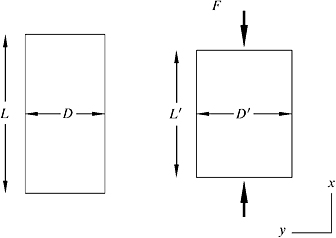Petroleum Related Rock Mechanics, 2nd Edition

The theory of linear elasticity deals with situations where there are linear relationships between applied stresses and resulting strains. While most rocks do behave nonlinearly when subject to large stresses, their behaviour may normally be described by linear relations for sufficiently small changes in stress. Consider a sample of length L and cross-sectional area A = D 2 (Fig. 1.15). When the force F is applied on its end surfaces, the length of the sample is reduced to L ?. The applied stress is then ? x = F/ A and the corresponding elongation is ? x = ( L ? L ?)/ L, according to Eqs. (1.1) and (1.58). If the sample behaves linearly, there is a linear relation between ? x and ? z, which we may write

Eq. (1.91) is known as Hooke s law, while the coefficient E is called Young s modulus or simply the E-modulus. Young s modulus belongs to a group of coefficients called elastic moduli. It is a measure of the stiffness of the sample, i.e. the sample s resistance against being compressed by a uniaxial stress.
Another consequence of the applied stress ? x (Fig. 1.15) is an increase in the width D of the sample. The lateral elongation is ? y = ? z = ( D ? D ?)/ D
